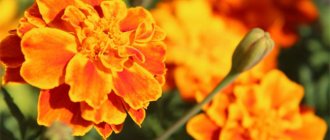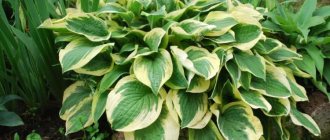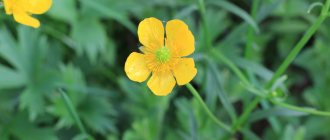Some specimens in the garden bloom profusely from early spring to the end of August and, like works of art, attract admiring glances, others are at the epicenter due to the decorativeness of their leaves and fruits. But garden plants that bloom until frost are also included in the category of favorite and reliable ones.
- 2 Autumn perennials
- 3 Tree-like shrubs
- 4 Table: other plants that bloom before frost
4.1 Photo gallery of cold-resistant flowering plants
Autumn annuals
The riot and richness of colors in a palette that has faded by the end of summer is added by annual and perennial plants that are not afraid of bad weather and sudden temperature changes. A brief description of the most famous representatives of the autumn flower bed is presented below.
The cold-resistant annual aster is undemanding to growing conditions. These flowers are classified depending on the height of the stem (short - up to 40 cm, tall - 60 cm), the fullness of the flower and the shape of the petals. Neutral acidity of the soil and moderate watering are the main requirements of the annual plant.
Bright and airy annual asters are dazzling in the autumn flower bed
Zinnia grows up to 90 cm, the flowers are slightly fragrant. It is photophilous and can withstand frosts of no more than -1 C°. Retains freshness in bouquets for a long time.
Many shades and ease of care encourage every gardener to diversify their garden beds with charming zinnias
Marigolds are decorative from July to the end of October, they are not afraid of frosts down to -3 C°, in addition, they grow and bloom in any conditions. The abundantly flowering plants, native to Mexico, come in short and tall varieties, with hairy and simple inflorescences.
The shades of marigolds vary from bright yellow to brown-orange.
Helenium is a herbaceous plant reaching 150 cm; brick-yellow daisy flowers are located on erect stems, but with a contrasting yellow or red frill along the edge of the petals. Heleniums can easily grow in the shade and tolerate frosts down to -3 C°, but prefer fertile soil with good drainage. The flowers of this plant look good in live bouquets, in floristry as dried flowers and in the background of flower beds.
Helenium flowers look good in living bouquets, as dried flowers in floristry and in the background of flower beds
Autumn annual flowers mainly reproduce by seeds.
https://1decor.org/rasteniya/cvety/osennie-cvety.html
Wildflowers in a garden plot in autumn
Heather continues its summer flowering in autumn. This plant is mentioned in the ballad "Heather Honey", about the last secret of the Picts, by Robert Louis Stevenson. This is truly a beautiful wildflower of Scotland and you can admire it in bloom even in autumn.
Fragrant heather
The blossoming of fragrant violets is an unforgettable sight
Anemone anemone also pleases with repeated flowering
Plant wildflowers, decorate your wonderful garden with plants that will bloom at different times, and you will always be in high spirits, which flowers will give you in gratitude for your care and concern.
And if you have questions for the author of the article or want to share your experience of caring for autumn flowers, leave your opinion in the form below.
Autumn perennials
Chrysanthemum is the queen of the autumn flower ball. Quite frost-resistant (flowers and leaves do not freeze during short-term frosts down to -5 C°), undemanding to watering. For abundant flowering, it is necessary to regularly feed with organic matter and mineral fertilizers.
The variety of colors and shapes of the flower, the specific wormwood aroma and ease of care - all this makes you fall in love with the late autumn beauty chrysanthemum
Sedum (sedum) with simple pinkish-smoky flowers collected in umbrellas is also attractive for its thick leaves. The plant blooms from the beginning of September to the first days of November and is not at all afraid of frost (down to -5 C°). Grows better in the shade; Requires excess moisture. Rocky soil and lack of fertilizing do not affect the flowering and growth of the subshrub. To propagate sedum, bushes are divided at any time during the growing season.
Sedum is not picky, even a novice gardener can grow it.
Flowers - pompoms of delicate shades on tall bushes (from 70 to 150 cm) - this is an English rose. Unlike its relatives, it is unpretentious and blooms until frost. For lush flowering, organic matter and mineral fertilizers are regularly applied. Powerful bushes require garter and timely pruning.
The English rose delights with its luxurious blooms until late autumn
The bright yellow tufts of goldenrod (solidago) will decorate any corner of the garden right up to frosts down to -1 -3 C°. This plant is represented by tall varieties up to 1.5–1.8 m and dwarf varieties - no higher than 40 cm. Goldenrod is a honey plant that exudes a spicy aroma; tall specimens are a hedge and partial shade for short neighbors. The shrub is unpretentious; propagated by root layering.
In addition to the described advantages, goldenrod has healing properties: solidus translated from Latin as “healthy”
Periwinkle
Periwinkle is an unpretentious plant that even a beginner can care for. Perennials are ground cover species. Flowers create a beautiful carpet on the site. Periwinkle petals can have a blue, light blue, or purple color. Flowering occurs twice a year - in April and July.
Periwinkle is planted under bushes and trees to suppress the growth of weeds, and they decorate rocky hills. Once every 3–5 years, the thickets of the plant are thinned out. Sowing is carried out in loose fertile soil, cutting grooves 1 cm deep.
Tree-like shrubs
Hydrangea is a shrub that blooms from mid-summer to late autumn. The plant consists of many species, differing in color and shape of the petals, height and splendor of the bush. Hydrangea is great in bouquets. This perennial is moisture-loving and responsive to fertilizing; for successful wintering, the shoots must be insulated; blooms until mid-October.
In late autumn, not only the flowers of Hydrangea paniculata, but also the foliage look decorative
Buddleia Davida is exotic for temperate latitudes with lilac or inky purple clusters of small fragrant inflorescences, grows up to 2.5 m. The plant does not like drafts; for abundant flowering it is necessary to fertilize. Blooms from early June to the last days of October. Perennial shrubs can be propagated using seeds and cuttings. For the winter, buddleia is covered.
Buddleia Davida is an excellent honey plant and a favorite of butterflies, which is why the plant is nicknamed the “butterfly bush.”
What flowers bloom in October?
The first days of this month are still pleasantly warm, but by the middle, the trees turn red and yellow, the leaves fall, and nature prepares for winter sleep. It is in October that you can see all shades of red, yellow and green. In contrast to the approaching cold weather, the Snapdragon flower comes into play. Its bright, rich buds still remind of hot summer. This plant family is known for its wide range of shades, ranging from red, purple and blue to snow-white and pastel. Another October favorite is the colchicum. The delicate buds and miniature size of the flower delight with its lightness and grace. Almost all plant varieties are in purple, blue and pink shades. Also among the graceful and noble plants of this month are crocuses, with their variegated, sophisticated petals and fiery cores. What other flowers can you find in October? Some of the most popular and in demand include:
- daisies;
- lobelia;
- nasturtium;
- dahlias.
All these plants easily tolerate the first cold and are not afraid of rainy and gloomy weather. Many of them are often used in flower arrangements and serve as home decorations.
Table: other plants that bloom before frost
| Name | Plant characteristics | Features of cultural development |
| Annual plants | ||
| Gatsania |
|
|
| Ageratum |
|
|
| Rudbeckia |
|
|
| Perennials | ||
| Aster novobelgienska (September) |
|
|
| Phloxes |
|
|
| Cosmea |
|
|
Photo gallery of cold-resistant flowering plants
Gatsania has flowers of bright, unique shades
Ageratum looks good on alpine slides in group plantings
Yellow rudbeckia daisies - expression in the autumn flower bed
Airy cosmos flowers remain beautiful until the first cold weather
New Belgian aster - everyone’s favorite September flower, unpretentious and cold-resistant
Phlox decorate flower beds from mid-summer until the end of September
The New Belgian aster was brought from North America and blooms from mid-September until the first frost (down to -5 C°). It is more like a shrub, as it grows up to 1.5 m and is unpretentious; We call it September. But it should not be confused with the Alpine one - this one is much lower, the flowers are larger and larger in diameter, and China is recognized as the birthplace of this plant. The flowering plant is more finicky and overwinters only under cover.
Calendula
It is popularly called marigold because of the unusual shape of the fruit. Catholic Christians decorated the statue of the Mother of the Savior with calendula and called it “Mary’s Gold”. The flower of “ten thousand years” is how it is called in China, where it symbolizes long life. In ancient India, garlands were woven from this plant and decorated with statues of saints.
Another name for the flower is “bride of summer” because of its ability to turn after the sun. The petals bloom in the light and gather in the shade. Because of this property, the ancient Romans called calendula “the master's dial.” They believed that in this way the plant lets them know about the onset of day and night. Another name is “calendar”. Currently, the double varieties with large inflorescences that have been bred have lost the ability to close at night, but this name remains.
Video: plants blooming before frost
The gloomy gray palette of autumn will surprise you with its variegated shades even after the first frost, and the wilting of the garden will be attractive and bright if the flowerbeds are filled with cold-resistant plants that bloom until late autumn.
- Author: Ksenia Bogacheva
I love my garden and my pets very much. I am always happy to share my knowledge and experience. Rate this article:
- 5
- 4
- 3
- 2
- 1
(49 votes, average: 4.3 out of 5)
Share with your friends!
Pansies
They bloom for a long period, starting in April and ending with the first frost. This is one of the plants of the autumn flower garden. The beliefs and legends associated with pansies are very beautiful. Here are some of them. In ancient times, there lived a beauty named Anyuta. One seducer broke the heart of a trusting girl who loved him with all her soul. From sadness and melancholy she sunbathed and died. Flowers grew on her grave, which were painted in three colors. They symbolize the feelings that the girl Anyuta experienced:
- surprise at injustice and insult;
- sadness associated with unrequited love;
- hope that reciprocity will arise.
The ancient Greeks considered three colors of pansies to be a sign of a love triangle. According to another legend, Zeus liked the daughter of King Io of Aragon. And his wife turned her into an animal - a cow. After long wanderings, she returned to her human form. Zeus grew violets as a gift to the girl. These flowers have always been a symbol of fidelity and love. Some peoples have customs associated with this plant. In England, they were presented to lovers on Valentine's Day, calling them “heart delight.” As a sign of love and fidelity, they were given to a lover in Poland when he was leaving for a long period. They were called “flowers for memory” in France. According to Roman mythology, they are associated with the image of Venus. The ancient Romans believed that the gods turned men into pansies who sneaked a peek at the goddess of love bathing.
goldenrod
Perennial with a wooden taproot, green trunk with shades of red at the bottom. Erect shoots with oval or elliptical foliage. The height of goldenrod ranges from 30 cm to 2 meters and has small hairs throughout the plant. Among the various varieties, the following stand out:
- Canadian;
- ordinary;
- giant.
This autumn plant blooms from May to October. It tolerates both dry and frosty weather conditions remarkably well. Attract insects with small abundant flowers.
Goldenrod can be propagated in several ways:
- Seeds.
- Seedlings.
- Dividing the bush.
- By cuttings.
Goldenrod does not require special care; regular watering in dry weather and staking tall bushes will help this plant bloom as long and brightly as possible. In winter, the flower does not need shelter; it is enough to cut the stems and leave 15 cm from the ground.
Crocosmia, Tritonia, Japanese gladiolus
An ornamental, showy plant of the iris family with bright orange, deep red or golden yellow flowers with a characteristic saffron scent.
Crocosmia is not very popular among summer residents, but is already winning the hearts of gardeners with its beauty and unpretentiousness. If you dig up and replant the plant in a special pot before frost in the fall, you can extend the life of the flower for another month in a cool place in a city apartment, for example, on a balcony.
Planting is carried out with corms, children and seeds. It is recommended to sow in February or March; as the seedlings mature, they are planted in pots and transplanted into open ground in May. It is recommended to plant corms in late April or early May.
Marigolds (Tagetes)
A plant of the Asteraceae family, which has earned respect for its assistance in pest control. The height of these plants ranges from 20 to 120 cm with yellow, brown or orange buds with a diameter of 2-10 cm.
There are three types of marigolds based on height:
- dwarf;
- short;
- tall.
Planting is done with seedlings and seeds in open ground; they bloom in 1.5-2 months.
Unpretentious, cold-resistant, bloom well after planting seedlings in fertilized soil. Recommended watering as it dries, without excessive moisture.
Monarda
A beautiful and almost exotic plant. The flowering period of monarda occurs in September. The leaves of this flower come in a variety of shades.
Besides, they are quite useful. They can be dried and then added to tea, the taste will be very similar to bergamot.
In the photo you see a beautiful, purple monarda flowering.
Flowering period: July, August. Up to 50 days.
But there are gardeners who plant perennial Monarda in the fall.
Decorative sunflower
Undoubtedly, in the fall everyone wants to get a little more summer sun. Therefore, a decorative sunflower that looks so similar to it will be an excellent choice for a flower bed in the fall.
You won’t be able to get seeds from it, but it will definitely please the eye and warm the soul on gloomy autumn evenings. Moreover, there are a great many varieties of sunflowers, there are even those that look like a very fluffy chrysanthemum.
And in the photo there is an autumn flowerbed, with just such a sunflower.
Flowering period: from July to autumn
With proper care and proper watering, a decorative sunflower will decorate the autumn flower garden for a long time.
Saxifraga
A perennial plant that blooms in autumn, is easy to care for and has a fibrous root system.
The height of the plant is 0.5-1.5 meters with leaves about 6 cm of emerald or grayish color. Saxifragas have small flowers, which are collected in racemes, paniculate inflorescences or arranged singly.
The color of the buds is varied - white, pink, yellow, red or deep crimson. In harsh climatic conditions, the flower is grown as an annual, since the plant cannot withstand cold temperatures.











